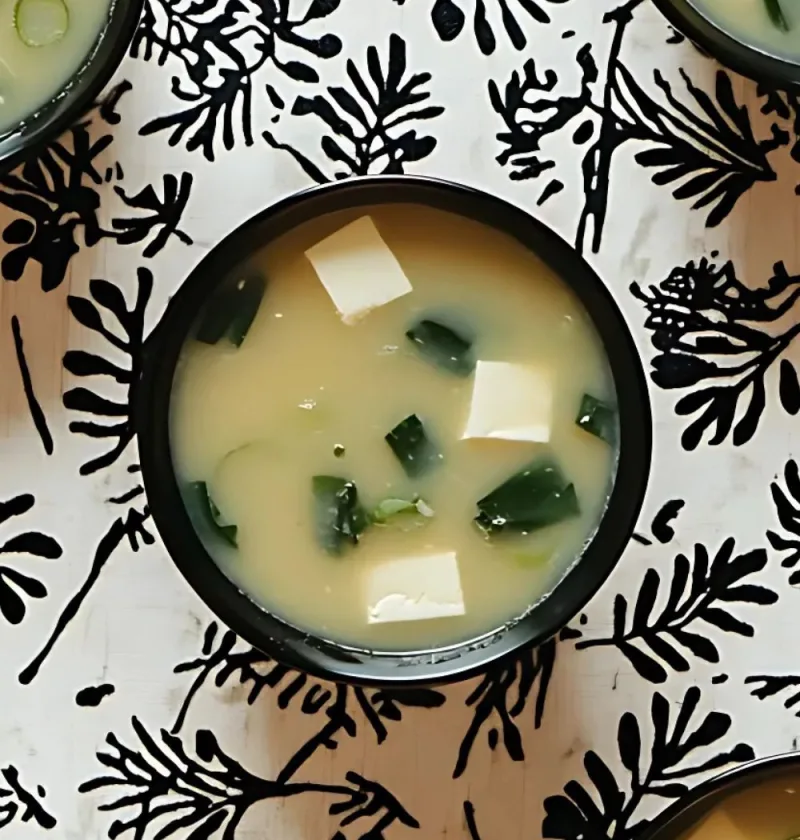After experimenting with all sorts of comforting recipes, I decided to finally give homemade miso soup recipe a go—and wow, I was not disappointed! It’s soothing, flavorful, and takes just 15 minutes to make. I’m always looking for recipes that warm me up from the inside out without needing an hour in the kitchen. This was a win.
The gentle umami flavor of miso mixed with silky tofu and soft seaweed hits the spot every time. While I was cooking it, I realized how easy it is to personalize, and now it’s a staple in my home.
And yes, if you’re into a taco soup recipe, you might be surprised how satisfying this light Japanese alternative can be on a different night!

Additional Tips for Making This Recipe Better
After making this miso soup more than a few times, I’ve picked up a few little tricks that elevate it every time. Here are my go-to tips that might help you enjoy it even more:
- Use white miso if you’re new to the flavor – It’s milder and slightly sweet, great for first-timers or those who want a lighter taste.
- Don’t boil the miso – Once it’s in, turn off the heat! Boiling miso kills its probiotic benefits and alters the taste.
- Cut tofu into small, uniform cubes – It’s easier to eat and blends better with the texture of the soup.
- Rehydrate wakame ahead of time – A few minutes in warm water is enough; don’t overdo it or it becomes too soft and slimy.
- Add mushrooms or baby spinach – I’ve tried both, and they add a rich, earthy flavor without much effort.
Tasty Variations to Try with Your Miso Soup
If you want to make this recipe your own, there are endless ways to switch it up. I love experimenting with soup flavors, and miso soup is a great base to build from.
- Dairy-free option – This soup is naturally dairy-free, so it’s perfect for those avoiding lactose.
- Low-sodium version – Use low-sodium miso paste or dilute your dashi slightly to control salt levels.
- Add-ins – Try thinly sliced shiitake mushrooms, baby bok choy, or even a soft-boiled egg for a heartier bowl.
- Spicy version – Stir in a bit of chili oil or a pinch of red pepper flakes for a kick.
- Protein boost – Add shredded chicken or edamame for extra protein without changing the flavor too much.
These tweaks let you enjoy one of the most classic soup recipes in a new way each time you make it!
Kitchen Tools You’ll Need
You don’t need fancy gear to make miso soup—just a few simple tools:
- Medium saucepan – Used to heat your dashi stock and combine all ingredients.
- Small bowl – Perfect for rehydrating the wakame seaweed.
- Ladle or small bowl – Use this to dissolve the miso before adding it to the pot.
- Cutting board and knife – For prepping tofu and slicing green onions.
How to Serve Miso Soup for the Best Experience
Presentation matters—especially when you’re serving something as simple as soup. I like to serve miso soup in small ceramic bowls with a sprinkle of extra green onions on top for color. You can even add a few sesame seeds or a swirl of chili oil for visual flair.
This soup pairs beautifully with a light rice dish or as a side to sushi or tempura. And if you’re planning a cozy soup night, try adding it to a rotation that includes a French Onion Soup recipe for a warming meal with global variety!

How to Store Miso Soup the Right Way
- Restoring: To restore flavor the next day, reheat gently on the stove without bringing it to a boil. Taste and adjust with a touch more miso if needed.
- Freezing: Avoid freezing miso soup with tofu, as tofu becomes rubbery. You can freeze just the broth and add fresh tofu and seaweed when reheating.
- Reheating: Heat on low until warm—never let it boil again once miso is in it. Stir occasionally for even warmth.
- Shelf Life: Stored in an airtight container, it lasts up to 3 days in the refrigerator. Beyond that, the flavor and texture start to degrade.
Why You’ll Love This Miso Soup Recipe
There’s something truly satisfying about making this from scratch. Here’s why it’s become one of my favorite quick meals:
- Fast and Easy to Prepare: It takes just 15 minutes from start to finish—perfect for weeknight meals or a soothing lunch.
- Customizable to Your Taste: You can tweak the miso, add vegetables or proteins, and still get a delicious result every time.
- Naturally Healthy and Light: Low in calories and made with whole ingredients—this soup is clean comfort in a bowl.
- Perfect Starter or Side Dish: It pairs well with other Japanese dishes or any simple rice-based meal.
- Warm, Umami Flavor That’s Soothing: The combo of dashi, miso, and tofu brings rich, calming flavors that are perfect for any season.
Final Thoughts Before You Cook
Miso soup is far simpler to make than it seems—and honestly, once I made it for the first time, I couldn’t stop. It’s like the comfort food I didn’t know I needed. The ingredients are basic, the process is quick, and the result is incredibly satisfying.
Here are a few more generic but helpful notes:
- Use fresh dashi if you can—it adds more depth than instant, though both work well.
- Always dissolve the miso separately in a ladle or bowl before adding it in.
- Keep it light—don’t overload it with too many add-ins if you want the classic flavor.

Miso Soup Recipe
Ingredients
Method
- Start by bringing 4 cups of dashi stock to a gentle simmer in a medium saucepan over medium heat. If using instant dashi, follow package instructions to ensure proper concentration. A gentle simmer, not a boil, is key to preserving the delicate umami.
- Place the dried wakame in a small bowl and cover it with warm water. Let it soak for about 5 minutes. It will expand significantly—up to 5 times its original size. Once plumped, drain off any excess water and set the seaweed aside.
- Gently add the cubed silken tofu and rehydrated wakame to the simmering dashi. Stir carefully so the tofu doesn’t break apart. Allow everything to warm through for about 2 to 3 minutes until the tofu is heated but not boiling.
- Scoop the miso paste into a ladle or small bowl. Ladle in a bit of the hot dashi and mix until the miso completely dissolves into a smooth liquid. Pour this mixture back into the saucepan. Stir gently to distribute the miso evenly. Never boil the soup after adding miso—it will lose its complex flavor and health benefits.
- Finally, add the thinly sliced green onions to the soup. Stir gently and remove the saucepan from heat immediately. The residual heat will slightly soften the onions while keeping their fresh flavor intact. Serve hot in small bowls and enjoy.






